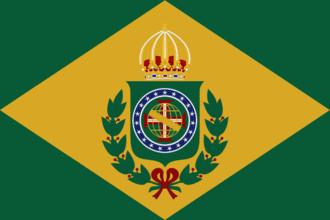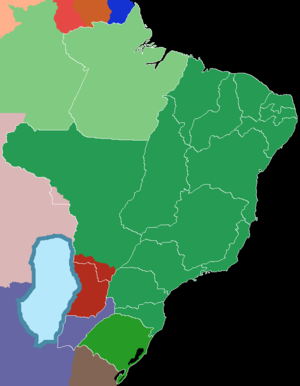「巴西在皇帝佩德羅一世退位留權給攝政後經歷了動盪期。巴西能成功克服這些障礙晉升列強嗎?」
巴西是位於南美的 ![]() 主要政權。作為地區面積最廣實力最強的國家,巴西佔有整個南美東部,但仍然問題繁多。最緊迫的問題莫過於遊戲開局時正在進行的兩場內戰——對抗 沒有結果和
主要政權。作為地區面積最廣實力最強的國家,巴西佔有整個南美東部,但仍然問題繁多。最緊迫的問題莫過於遊戲開局時正在進行的兩場內戰——對抗 沒有結果和 ![]() 皮拉蒂尼。在解決叛亂分子之後,巴西將與南美除
皮拉蒂尼。在解決叛亂分子之後,巴西將與南美除 ![]() 智利和
智利和 ![]() 厄瓜多爾之外的所有國家接壤,但與
厄瓜多爾之外的所有國家接壤,但與 ![]() 秘魯的疆界位於雨林深處,無法通行。
秘魯的疆界位於雨林深處,無法通行。
歷史背景
巴西地區最早由葡萄牙人在16世紀初期發現。1807年,拿破崙戰爭時期,葡萄牙遭到法國和西班牙入侵,統治葡萄牙的布拉干薩王室從里斯本流亡至里約熱內盧。半島戰爭結束後的1815年,巴西從殖民地升格為王國,成為了葡萄牙-巴西-阿爾加維聯合王國的一部分。1820年,葡萄牙本土爆發自由黨人革命,革命成立的憲政議會請求若昂六世回到歐洲,將王儲佩德羅留在巴西。若昂六世回到歐洲後,議會企圖取消之前授予巴西的各項特權,使其重歸殖民地。一時間,巴西獨立運動高漲,王儲佩德羅順應民意,並希望在不破壞君主制和布拉干薩王室的基礎上建立獨立的新國家。
1822年9月,在巴西人民要求和葡萄牙議會施壓的雙重影響下,佩德羅在聖保羅拔劍宣誓「不獨立,毋寧死!」(Independência ou Morte!),正式宣告了巴西獨立,同年加冕為巴西皇帝,稱佩德羅一世。1825年,葡萄牙承認巴西獨立。1826年,葡萄牙若昂六世去世,按照繼承法應當由佩德羅繼承王位,但葡萄牙議會不能接受一位同時擁有巴西和葡萄牙兩國頭銜的君主,因此佩德羅將葡萄牙王位讓給長女瑪利亞·德·布拉干薩。佩德羅一世對內主張中央集權,鎮壓共和運動,對外為獲得獨立而親近英國,導致英國工業品和資本的大量流入,英國艦隊甚至有權在巴西商船上搜查奴隸。1825-1828年,巴西在與阿根廷爭奪烏拉圭的戰爭中損失巨大,被迫承認烏拉圭獨立。再加上王室的混亂關係和對葡萄牙舊貴族的維護,使得佩德羅喪盡民心,不得不於1831年出走葡萄牙,將帝位讓位給5歲的兒子佩德羅二世。
佩德羅二世在位時期,巴西經歷了多次起義和叛亂。三十年代中葉,南里奧格蘭德省共和派起義,史稱破衫漢戰爭,北方大帕拉省爆發了卡巴納吉起義。1840年佩德羅二世親政,逐步擺脫葡萄牙貴族對政治的影響。他思想開明,執政期間大力發展經濟,建設基礎設施,保護民族工業,接納新興科技。政治上在自由派和保守黨的鬥爭中調停,並積極採納進步主義的法律,受到巴西各界的肯定,獲得了「寬宏大量」(O Magnânimo)的美譽。1888年,巴西的奴隸制度正式廢除。但憤怒的種植園主和軍方不滿皇帝政策的自由主義傾向,同共和派一道發動了政變推翻了佩德羅二世的統治,建立共和國。
成立與釋放
|
|
請幫助驗證或更新此部分。 它最後被驗證的 版本是 1.5。 |
若巴西不存在,可由 ![]() 安哥拉然加或 沒有結果在控制巴西
安哥拉然加或 沒有結果在控制巴西 ![]() 文化本土的14塊核心地區後成立,也可以由任意控制其首都里約熱內盧的國家釋放
文化本土的14塊核心地區後成立,也可以由任意控制其首都里約熱內盧的國家釋放
日誌與決議
- 主條目:巴西日誌條目
科技
|
|
請幫助驗證或更新此部分。 它最後被驗證的 版本是 1.5。 |
巴西開局時已研發大部分第一時代科技。
政治
|
|
請幫助驗證或更新此部分。 它最後被驗證的 版本是 1.5。 |
巴西是一個立憲帝國,由尚未成年的佩德羅·德·布拉干薩,這位支持 ![]() 知識分子集團的皇帝統治。
知識分子集團的皇帝統治。
| 權力結構 | 經濟 | 人權 | |||
|---|---|---|---|---|---|
| 治理原則 | 經濟體制 | 言論自由 | |||
| 權力分配 | 貿易政策 | 勞動者權益 | |||
| 公民權 | 賦稅 | 兒童權利 | |||
| 教會與國家 | 土地改革 | 女性權利 | |||
| 官僚體制 | 殖民機構 | 社會福利 | |||
| 軍隊類型 | 警察機構 | 移民制度 | |||
| 國內安全 | 教育體制 | 奴隸制 | |||
| 衛生系統 | |||||
| 類型 | 機構等級 |
|---|---|
| 1 | |
| 1 |
利益集團
![]() 知識分子是遊戲開局時
知識分子是遊戲開局時 ![]() 執政的唯一利益集團。
執政的唯一利益集團。 ![]() 在野的利益集團中,
在野的利益集團中,![]() 鄉村民眾對任何黨派都無興趣,
鄉村民眾對任何黨派都無興趣,![]() 地主和
地主和 ![]() 軍隊共同組建了
軍隊共同組建了 ![]() 溫和黨,而
溫和黨,而![]() 天主教會、
天主教會、![]() 實業家和
實業家和 ![]() 小市民組成了
小市民組成了 ![]() 崇高自由黨。
崇高自由黨。![]() 工會處在
工會處在 ![]() 邊緣利益集團。
邊緣利益集團。
巴西的知識分子擁有 ![]() 立憲主義者意識形態,替代了通用的
立憲主義者意識形態,替代了通用的 ![]() 共和主義者,意味着他們不會支持共和制替代君主制。
共和主義者,意味着他們不會支持共和制替代君主制。
歷史角色
外交
Brazil starts in two separate civil wars: against the ![]() 皮拉蒂尼 and 沒有結果. Luckily, there are no other involved parties, and as the wars have already broken out, no outside parties can directly intervene.
皮拉蒂尼 and 沒有結果. Luckily, there are no other involved parties, and as the wars have already broken out, no outside parties can directly intervene.
Brazil has ![]() claims on the state of Amazonas, which is owned in part by Grão-Pará,
claims on the state of Amazonas, which is owned in part by Grão-Pará, ![]() 玻利維亞, and
玻利維亞, and ![]() 哥倫比亞. It has no diplomatic pacts, but
哥倫比亞. It has no diplomatic pacts, but ![]() 葡萄牙 starts with
葡萄牙 starts with ![]() cold relations.
cold relations.
經濟
|
|
請幫助驗證或更新此部分。 它最後被驗證的 版本是 1.5。 |
| 數據 | 初始值 | 排名 |
|---|---|---|
| 15 | ||
| 4.04M | 27 | |
| 20.10% | 78 | |
| 130 |
地區
工業與資源
- Industry
Brazil has minimal industry, with a somewhat more developed agricultural sector, notably in ![]() Coffee Plantations.
Coffee Plantations.
- Resources
Brazil has several states with the ![]() Amazon Rainforest trait, boosting
Amazon Rainforest trait, boosting ![]() production. Combined with a very large potential for
production. Combined with a very large potential for ![]() Logging Camps, wood production is really Brazil's trump card. The downside is that the Amazonan also decreases infrastructure and construction efficiency. On top of that, there are multiple states with traits increasing agricultural production. The
Logging Camps, wood production is really Brazil's trump card. The downside is that the Amazonan also decreases infrastructure and construction efficiency. On top of that, there are multiple states with traits increasing agricultural production. The ![]() Pampas modifier in soon-to-be-reconquered Rio Grande do Sul gives +15% agricultural throughput and so does the
Pampas modifier in soon-to-be-reconquered Rio Grande do Sul gives +15% agricultural throughput and so does the ![]() Pantanal in Mato Grosso, although the latter comes with a −10% infrastructure reduction.
Pantanal in Mato Grosso, although the latter comes with a −10% infrastructure reduction.
Later, both ![]() and
and ![]() become available in Brazil. The one glaring lack is
become available in Brazil. The one glaring lack is ![]() , which needs to be imported or a source colonized or conquered.
, which needs to be imported or a source colonized or conquered.
公司
| 名稱 | 增益建築 | 繁榮度獎勵 | 成立條件 |
|---|---|---|---|
|
+10% 工藝裝備工坊建築吞吐量 |
任意已整合地區:
| ||
|
+15.00% 咖啡種植園吞吐量 |
聖保羅:
已整合地區中有至少4個:
| ||
|
File:Building military shipyards.png 軍用造船廠 |
里約熱內盧:
| ||
| File:Building textile mill.png 紡織廠 |
+10% 棉花種植園建築吞吐量 |
伯南布哥:
| |
|
+5% 彈藥廠建築吞吐量 |
聖保羅:
| ||
|
+10% 畜牧場建築吞吐量 |
南里奧格蘭德:
|
軍事
|
|
請幫助驗證或更新此部分。 它最後被驗證的 版本是 1.5。 |
Brazil starts with 33 ![]() Battalions and can call upon 19 Conscript Battalions. All Barracks use
Battalions and can call upon 19 Conscript Battalions. All Barracks use ![]() No Organized Training. The battalions are divided into three armies.
No Organized Training. The battalions are divided into three armies.
| 軍隊名稱 | 編制 | 將領 | 總部區域 |
|---|---|---|---|
|
Pedro de Alcântara Bellegarde | Brazil | |
|
Pierre Labatut | Brazil | |
|
— | 巴西 |
南國陸軍正在南部的 ![]() 皮拉蒂尼前線部署,亞馬遜陸軍正在與 沒有結果交戰的前線駐紮。
皮拉蒂尼前線部署,亞馬遜陸軍正在與 沒有結果交戰的前線駐紮。
Brazil starts with 10 ![]() Flotillas. All Naval Bases use
Flotillas. All Naval Bases use ![]() Naval Traditions.
Naval Traditions.
| 艦隊名稱 | 編制 | 將領 | 總部區域 |
|---|---|---|---|
|
約翰·格倫費爾 | 巴西 |
策略與指南
|
|
請幫助驗證或更新此部分。 它最後被驗證的 版本是 1.5。 |
Brazil truly has the potential to be a world power. But it is certainly not a given, when looking at Brazil's many problems.
Opening moves
The first thing to do is to win the to civil wars. It should not prove much of a problem. The two generals should be able to handle both with the standing army alone. Hold one back in defense, while you take care of the other.
Afterwards, Brazil can attack either ![]() 哥倫比亞
哥倫比亞![]() 烏拉圭, or
烏拉圭, or ![]() 巴拉圭.
巴拉圭.
Expansion locally
Brazil can beat any other country in South America, and unifying the entirety of South America is not out of the question. One can simply start from one end and continue from country to country. The only thing holding Brazil back is potential European or North American interference. So one should make sure to be diplomatically on the good side of France, Great Britain, and the USA.
The only resources that Brazil completely lacks, Sulphur, is luckily found in abundance in ![]() 秘魯, so long term, getting access to these mines should probably be a priority.
秘魯, so long term, getting access to these mines should probably be a priority.
Joining a market
The main thing holding Brazil back from long term growth is the lack of coal and initially the lack of iron and steel. Early game, it can be very beneficial to join a larger market (France and UK are the obvious once) to get a access to industrial goods. There Brazil can specialise in selling agricultural products and wood, which can be very profitable.
成就
參考資料
- ↑ 無法使用,因其不是沿海地區




